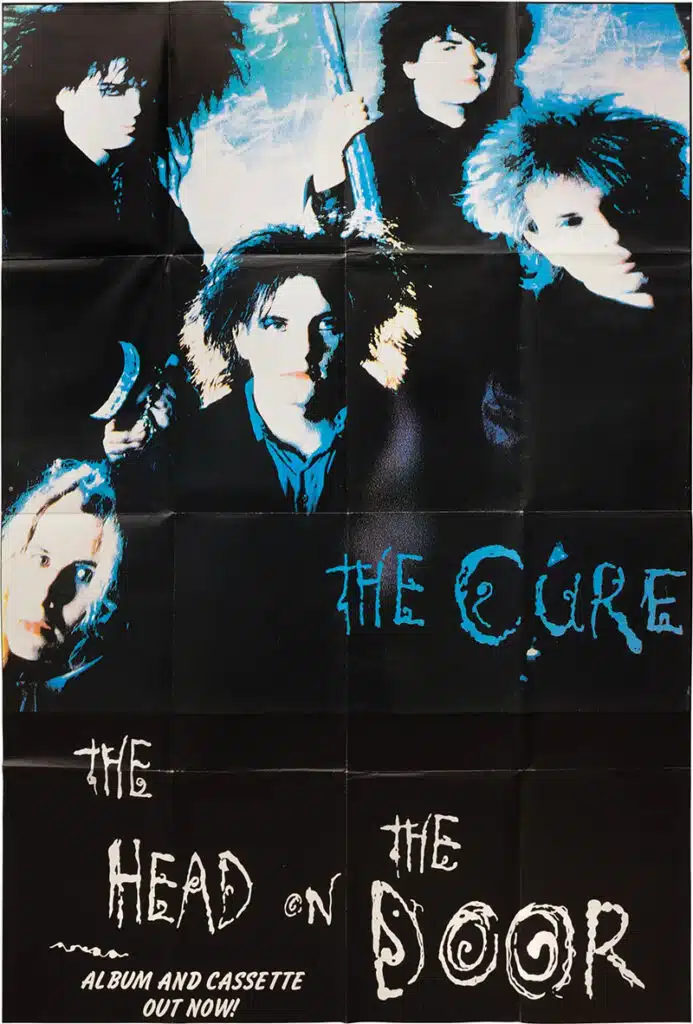40 Years of the Remedy’s First True Surrealist Pop Album » PopMatters
Final yr marked the discharge of the Remedy’s long-gestating 14th album, the critically acclaimed Songs of a Misplaced World. The document is extra akin to downtempo, introspective albums like Pornography, Disintegration and Bloodflowers than those in the Remedy cannon that skew extra upbeat, reminiscent of 1987’s Kiss Me Kiss Me Kiss Me, and the breakthrough that arrives this yr on the doorstep of its fortieth yr, The Head on the Door.
The Head on the Door was the primary Remedy album to interrupt them into broader consciousness in 1985. It’s nonetheless beloved at this time by critics and followers alike as a paragon of musical cohesion and as one of many information that formed the extra mystical pop soundscapes of the Nineteen Eighties.
For a lot of, The Head on the Door was the gateway drug into the Remedy cosmos, that dichotomously pleasant and disturbing dream dimension that in the end defies description and but one way or the other makes good sense. The Remedy cosmos, you see – music, lyrics, movies, visuals, vogue – possesses a logic all its personal, and The Head on the Door is the apotheosis of that captivatingly peculiar realm of cause.
Certainly, you may say that The Head on the Door is the primary correct surrealist pop album. Not solely do the Tim Pope-helmed movies showcase the Remedy’s quirky visible mien – members sporting manic, gravity-defying manes and raveled clothes that means toddler tantrums – however the songs seize the unconscious paradoxes that always solely make sense in hallucinatory moods.
That’s exactly what surrealism, as each a historic motion and fashionable type, goals towards: producing alternate states of consciousness that invoke incongruous imagery, startling the senses and subverting actuality as we all know it. In different phrases, lucid hallucinations. These hallucinations may be sleep-induced or curated in purely wakeful states which might be subtly attuned to a grittier actuality beneath the floor. Or, they are often drug-inspired.
The Remedy are well-known for his or her youthful drug habits, in any case, however the ingestion of hallucinogens by the band allegedly reached its zenith on The Head on the Door predecessor, The Prime. The Prime is a masterwork of psychedelic mindfuckery. Nevertheless, the place The Prime takes us on a darkish and delirious Alice in Wonderland misadventure, The Head on the Door attracts us out of that rabbit gap into one which results in a lighter place merely tinged with noir.
The place The Prime was a magic mushroom tea musical, The Head on the Door is a neon nightmare, emphasizing the neon glow-in-the-dark pop songs that collect the gloom and switch it inside out. We’ll begin with the duvet – the titular visible whose ghastly glow and blurry, bleary picture has some kinship with the fantastical works of Max Ernst, Salvador Dali, and Toyen and hints on the (dis)contents inside. This picture (really a manipulated {photograph} of vocalist Robert Smith’s sister) is supposed to conjure a imaginative and prescient Smith noticed in a dream (“He noticed his personal indifferent head caught to his bed room door.”).
Then now we have the cartoonishly creepy, swirling lettering. Each the visible and the lettering had been rendered by the Parched Artwork collective composed of artist Andy Vella and Remedy guitarist Porl Thompson, who would go on to design different notable Remedy album covers as nicely. For a gal like me on the cusp of her 20s as I used to be in 1985, consumed primarily with the traditional rock and glossy pop of the occasions, the trippy The Head on the Door cowl alone was sufficient to encourage me to buy the tape at my native document retailer utopia, Sundance Data in San Marcos, Texas.
I had not heard one peep of the songs inside. The Remedy had been on the cusp of turning into MTV darlings, but it surely hadn’t fairly occurred but, so I used to be blind to the idiosyncratic charms of the group till the very second I occurred upon the cassette. My poetic self was beginning to come to sharper fruition, and I used to be intrigued by the otherworldly cowl and title of The Head on the Door.
Rising up, my professor mother and father had taken us to Europe, the place we visited many ruins and museums, germinating a lifelong visible artwork obsession. So, I used to be attuned to visible artwork in all media, and within the case of The Head on the Door, I very blatantly judged a tape by its cowl. I figured the music inside should match the intriguingly unorthodox cowl.
Once I popped the tape into my house cassette participant, let’s simply say my “head” exploded. The opening music and lead single, “Inbetween Days”, unfurled, yielding a jangle-pop/synthpop hybrid that vocally and lyrically captures that the majority invigorating of contradictions: an ebullient wistfulness. The singing begins joltingly: “Yesterday I bought so previous I felt like I may die.” Instantly, we all know we’re not in for a cheerful trip, nor will we be transported straight into hell; moderately, we’re guided towards a purgatory of utmost moods and sensibilities.
The place 1982’s fantastically bleak Pornography took the Remedy to the sting of the proverbial abyss. Subsequent early titles like “The Lovecats” hinted on the dizzy, fizzy pop that will later leap off of the Kiss Me Kiss Me Kiss Me album, The Head on the Door reveled within the compelling contrasts that lurked throughout the sounds and lyrics. The sunny synths and high-energy guitar strumming in “InBetween Days” collide towards a extra mournful bassline, and lyrics and vocals are coloured with melancholy.
Can we discuss in regards to the texture of Robert Smith’s voice for a minute? As a molten mirror involves life, his voice is probably the most recognizable facet of the band’s signature sound. In some ways, his voice exists as its personal instrument, able to invoking giddy highs and dreadful lows whereas sounding liquified, gleaming, haunting.
“Inbetween Days,” with its emphasis on “trios”, as per Robert Smith (“days, individuals, locations”), can also be augmented by an iconic video directed by none aside from iconic videographer Tim “Pap” Pope, who has produced dozens of the band’s movies and some of their live performance movies as nicely, together with “The Remedy: Anniversary 1978-2018 Stay in Hyde Park”. The Remedy and “Pap”, suffice it to say, have a legendarily synergistic relationship.
As soon as I considered the “Inbetween Days” video, there was no turning again from this surrealistic pop group’s gravitational pull on my soul. My life virtually immediately metamorphosed into one thing extra whimsical and cerebral.
The brilliant/darkish dynamic of “Inbetween Days” leads seamlessly into the subsequent monitor, a tune infused with Far Jap shadows, “Kyoto Track”. In keeping with Robert Smith, it was impressed by a fever dream and the worry that his lifelong love, Mary Poole, would drown. This music was my foray into mystical music that would saturate the senses.
The invention of The Head on the Door dovetailed with my entry into school, the place I’d quickly be uncovered to the symbolist literature of Arthur Rimbaud and Charles Baudelaire. At my small, rural, but wholly respected liberal arts school, I’d even be launched to artwork like Joan Miro’s. So my social life (dancing at goth golf equipment, going to punk events, sporting freaky fashions) and tutorial life unusually converged. Surrealism was making its mark in each my faculty and social realms.
“Kyoto Track”, with its calmly ominous oriental aura, offers technique to the overtly flamenco-flavored “The Blood”, which emerged after Robert Smith imbibed an inexpensive Portuguese wine referred to as Lachryma Christi. The fierce flamenco guitars, castanets, and a danceable beat fortifying Smith’s intonation of “I’m paralyzed / By the blood of Christ” invoke an environment of non secular dread.
After the one-two world music gut-punch of “Kyoto Track” and “The Blood”, we slide into the off-kilter cubist pop of “Six Completely different Methods”, whose darkly playful piano tones pilfer instantly from “Swimming Horses”, a music crafted throughout Smith’s time in Siouxsie and the Banshees. On the floor, “Six Completely different Methods” is a love music, however additionally it is about, as Smith hints, “a number of personalities”.
The eternally electrifying “Push” wraps up aspect one and options probably the most savory of Remedy signatures: the epic instrumental intro. Smith claims a visit house impressed it, but it surely takes a darker flip into paranoia a couple of love triangle state of affairs. Like many early Remedy lyrics, these lyrics harbor cryptic meanings and are sometimes predicated on clashing concepts, beliefs, and inspirations. Surrealist poetry is rarely simple; its attraction and affect lie in its secret symbols and ulterior logic. Over time, “Push” has change into a fan favourite at Remedy exhibits, as its exhilarating intro and chorused shouting of “GO! GO! GO!” and “NO! NO! NO!” actually pushes the gang right into a frenzy.
I distinctly keep in mind that once I first heard aspect two’s opener, “Child Screams,” I assumed I had entered one other dimension. On reflection, it’s not even probably the most weird of Remedy songs (for me, that will be “A Man Inside My Mouth” from Be part of the Dots and likewise the EP Quadpus), however on the time, I had solely skilled Pink Floydian psychedelia. “Child Screams”, then again, is soaringly psychedelic in a means that deranges the senses, a precept that Rimbaud advocated in his poetic worldview.
The monitor’s wailed pleas of “heaven, give me an indication” amid “ineffective” ready for “nothing in any respect” appear to be an virtually suicidal supplication to the universe. The high-pitched howl emanating from Smith is completely matched by guitars that swirl and swell; your complete music offers a sense of transcendent ascension even because the lyrics appear mired in hopelessness.


Whereas The Head on the Door has been famous for its fluidity, that doesn’t imply it has an omnipresent temper. The songs circulation effortlessly into one another, indicating a cohesive sound palette, however they possess their very own persona; they aren’t monochromatic replicas of one another by any stretch.
“Near Me”, the second and most profitable single from The Head on the Door and presumably the centerpiece of the album, is a lighthearted lament about “impending doom”, whose cozy claustrophobia is embodied in Tim Pope’s iconic “wardrobe video”. The music options handclaps, a chirpy keyboard, heavy respiration, and vocals of virtually childlike angst. The anxious lyrics and vocals entangle with the capricious music in a means that jitters the nerves; there’s even a lyrical nod to the document title (“If solely I used to be certain that the top on the door was a dream”), cementing its standing because the piece de resistance of the album.
“A Evening Like This” is the next music and the third and remaining single whose “phrases had been written within the rain”, in response to Smith. It incorporates a darkish and stormy evening temper, with imagery evoked of lovers parting right into a midnight void and a determined search ensues. Romantic nervousness is a standard Remedy theme, and this music, specifically, showcases probably the most simple, least surrealist music on The Head on the Door. Musically, it has muscle, too, and is clearly impressed by extra conventional rock formulation, largely eschewing dreamlike qualities for a barely extra orthodox method. There’s even a saxophone solo.
That brings us to the final two songs that deliver us again into the surrealist-pop fold with “Screw” and “Sinking”, two diametrically opposed songs tone-wise, with “Screw” standing out for its jarringly abrasive textures and drug-induced lyrics, and “Sinking” mimicking a drowning mode, with deeply meditative piano and bass and a slow-motion development, wrapped round lyrics about getting older and turning into much less genuine.
The Head on the Door is the sound and the look of the Remedy coming into their very own. They might proceed to evolve as a result of they don’t know how you can keep nonetheless; The Remedy are stressed and relentless shape-shifters. However with The Head on the Door, they reached a wider viewers, cultivating a extra accessible pop sensibility whereas infusing surrealistic seasonings to fulfill their hardcore base. Robert Smith mentioned with The Head on the Door that he meant to make pop music within the type of “Strawberry Fields”, and he succeeded. The Remedy, in any case, have typically been tagged the “The Different Beatles.”
By 1986, The Head on the Door had bought 250,000 copies, far exceeding the 50,000 or so common of earlier information. Melody Maker named it their Album of the Yr, and “Inbetween Days” was the primary single of the Remedy that appeared on the US Pop Charts, peaking at quantity 99. Simply 4 years after The Head on the Door, the Remedy could be taking part in to 50,000 individuals upon the discharge of Disintegration, their best-selling document.
Nevertheless, The Head on the Door was the album that began all of it: It inaugurated the Remedy’s ascent into enviornment stratospheres. With the assistance of Tim Pope, the Remedy would lastly change into the MTV darlings they had been destined to be, flaunting their darkly whimsical musical persona like a surrealist portray come to life.








